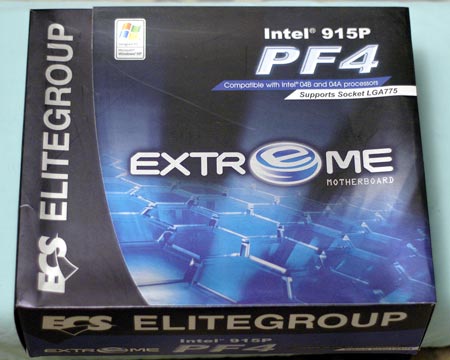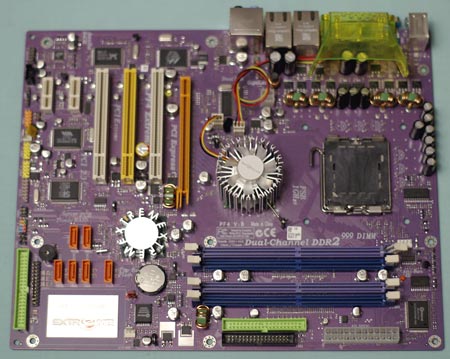915 Motherboard Roundup: Socket 775 for the Rest of Us
by Wesley Fink on December 7, 2004 12:25 AM EST- Posted in
- Motherboards
ECS PF4 915P Extreme: Features and Layout
| ECS PF4 915P Extreme Motherboard Specifications | |
| CPU Interface | Socket 775 Pentium 4 (Prescott) |
| Chipset | Intel 915P/ICH6 |
| BUS Speeds | 200MHz to 510MHz (in 1MHz increments) |
| DDR2 Speeds | Auto, 400, 533 |
| PCI Speeds | Asynch, Synch |
| Core Voltage | Auto, 1.125V to 1.5875V in .015V increments |
| DRAM Voltage | 1.8V to 2.2V in 0.1V increments |
| PCIe Voltage | 1.50V to 1.675V in .025V Increments |
| Memory Slots | Four 240-pin DDR2 Slots Dual-Channel Unbuffered Memory to 4GB |
| Expansion Slots | 1 PCIe x16 Slot 2 PCIe x1 Slots 3 PCI Slots |
| Onboard SATA/RAID | 4 SATA 150 drives by ICH6 Plus 2 SATA 150 by SiS 180 (SiS drives can be combined in RAID) |
| Onboard IDE/RAID | One Standard ATA100/66 (2 drives) Plus 2 Ultra ATA 133/100/66 By SiS 180 (SiS drives can be combined in RAID) |
| Onboard USB 2.0/IEEE-1394 | 8 USB 2.0 ports 2 IEEE 1394a FireWire Ports by VIA VT6307 |
| Dual Onboard LAN | Gigabit PCI Ethernet by Marvell 88E8001 10/100 PCI by Realtek 8100C |
| Onboard Audio | C-Media CMI9880 8-Channel with SPDIF |
| Tested BIOS | 1.1a AMI |
In the last year, ECS has been pushing for greater respect at the top end of the motherboard market with flashier designs and adjustment options associated with top-end boards aimed at the enthusiast. They call these boards their "Extreme Motherboards" and the PF4 915P is part of the new series. What makes the board Extreme? For starters, it is the packaging.

The PF4 915P comes in a foil box with an information flap, more like you would see with a Gigabyte board. Fortunately, ECS opted for a subdued blue, silver and black design that doesn't shout off the shelves. Inside the box is a very Abit-like group of fitted inside boxes for manuals and accessories. A very complete range of accessories is included. Particularly noteworthy are round black cables. Also included is a slot mount or 3-1/2 inch bay mount USB2/Firewire port bracket. This option is very clever and worth copying by other manufacturers. Despite the high-end image and packaging, ECS has priced the PF4 915P to compete with mainstream boards, as it is currently selling in the $120 to $130 price range in web stores.
The board itself is a soft medium purple with color used to locate most-used connectors easily. You can see the rounded corners, huge active Northbridge heatsink, and a Southbridge sink with fins that spell "EXTREME". ECS even includes a rear exhaust fan in the IO area to pull heat from the CPU area of the 4-phase design.

Layout of the PF4 915P is very clean. In addition to the huge standard list of 915P features, ECS adds a SiS 180 controller for 2 additional SATA ports and an added IDE connector. The SiS ports can be combined in RAID - a good thing, since ECS chose to use the ICH6 south bridge without RAID capabilities. Two Firewire ports are also provided for those who want on-board Firewire, and the Azalia high-definition 8-channel audio is driven by a C-Media codec.
Layout is better than average. Thankfully, the IDE and floppy connector are in our preferred right edge location, with the added IDE connector at the bottom edge. The 24-pin ATX power connector is also on the right edge, out of the way in most cases. The 4-pin connector, however, is near the center of the board between the CPU and rear IO ports, requiring the cable to be snaked around the CPU. We prefer a board-edge location, but the cable is actually easier to maneuver, since it has just 4 wires.
ECS makes quite a bit of noise about the Dual LAN capabilities of the PF4. Dual LAN is a nice feature, but in this case, one is Gigabit and one is 10/100. To make matters worse, both LANs are on the PCI bus. This is not an issue with the 10/100, but the Gigabit LAN would have been much more capable on the PCI Express bus.
All-in-all, there is little to complain about the layout or features provided on the ECS. It would have been nice to see an ICH6R instead and a PCIe Gigabit LAN, but these will only be important to some users. The BIOS options are certainly much more generous than what we are accustomed to seeing with ECS designs. ECS appears to have met their design goal of positioning the PF4 915P Extreme as a premium board with a nice mainstream price. If performance and overclocking match the layout and features, ECS will have a potent player in the market.
DFI LANParty UT 915P-T12: Overclocking and Stress Testing
ECS PF4 915P Extreme: Overclocking and Stress Testing










26 Comments
View All Comments
Live - Tuesday, December 7, 2004 - link
Sorry Didn't see your reply before I posted Wesley.Sure there is some value to be had but not "outstanding". I still don't agree with you but I guess my mind is made up. Intel needs to come out with something new before I go back.
As a roundup it was very good reading tough. I can't wait for the next AMD roundup to hit AnandTech.
Live - Tuesday, December 7, 2004 - link
#12"The P5GD2 is an expensive motherboard, at about $240 on the web, but you can get almost all the same features in the P5GD2 Deluxe for about $50 less."
Thats expensive to me. Compare that to the 134.99 for the 939 Gold Editors Choice winner "MSI K8N Neo2 Platinum"
But thats not the point. If the 915P was substantially cheaper then a 939 system you might call it value for money but is it not. Mind you a 939 board is generally not cheap either but at least it delivers in comparison.
The CPU used in the review that hardly beat the much cheaper 3500+ had a max overclock of 14% and I bet you would find it hard to reach that high without the CPU overheating and start throttling http://www.anandtech.com/news/shownews.aspx?i=2345...
LGA775 CPUs does not offer great overclocking headroom compared to the much cheaper earlier Intel platforms or AMD for that matter. Sure they still overclock but nothing that we haven't seen before at higher cost and temperature. Again not what I would call outstanding.
Wesley Fink - Tuesday, December 7, 2004 - link
#11 - We just ran the 3500+ benchmarks in the same configuration this morning, and we do agree that the 3500+ is a particularly good value in performance for the dollar. However, the larger picture of prices of AMD CPUs compared to Intel show the Intel processors are a good, if not outstanding, value.Our conclusion was based on Anand's value analysis in the 3.46EE/1066 launch review at http://www.anandtech.com/cpuchipsets/showdoc.aspx?... There he compared the 3800+ at over $600 to a Intel 560 3.6GHz at about $450 and found the 3800+ the winner but probably not a big enough winner to justify the price premium for the 3800+. At that time, there was no 570 (3.8GHz) and the 3.6 was the fastest Intel CPU unless you considered the $1000+ Xeon-based EE processors. Price changes continue, and with them the value relationships do change.
A quick check of prices today shows
Intel 520(2.8GHz)- $160 AMD 2800+(754) - $128
Intel 530(3.0GHz)- $180 AMD A64 3000+ - $152
Intel 540(3.2GHz)- $220 AMD A64 3200+ - $194
Intel 550(3.4GHz)- $282 AMD A64 3400+ - $269
Intel 560(3.6GHz)- $455 AMD A64 3500+ - $270
Intel 570(3.8GHz)- $795 AMD A64 3800+ - $630
AMD A64 4000+ - $716
AMD A64 FX55 - $812
With current prices we would have to agree that there is really no great value advantage to Intel any more. But there is good value in the Intel processors from 2.8GHz (520) to 3.6GHz (560). Certainly the 4000+, at $80 less than the 570 and faster performance, and the FX55 at about the same price as 570 and significantly faster in most benchmarks, are better value at the top. But we still stand by Intel being good value in the middle.
deathwalker - Tuesday, December 7, 2004 - link
"outstanding value and performance for your buying dollar" ?????????? at $240 for a Mobo?..I guess I need to retake Economics 101...Bah...Intel just continues to shot themselves in the foot. A side note not related to this review..Dell must be deep inside of Intel's pocketbook with there contiued refusal to market AMD based products.danidentity - Tuesday, December 7, 2004 - link
#11 - 915P motherboards are not expensive. They are equal or cheaper in price than socket 939 A64 motherboards.LGA775 CPUs offer great overclocking headroom if paired with the right board. Intel CPUs have traditionally have had more OCing headroom than AMD chips. That still holds true, for the most part, today. Especially when talking about the low-end chips, like the 2.8GHz.
Live - Tuesday, December 7, 2004 - link
I'm sorry but I don't see the "outstanding value and performance for your buying dollar"Expensive Motherboards and CPUs with little overclocking headroom compared to the Athlon 64 competition. How does that translate to excellent value and performance? even the much cheaper 3500 comes out on top on most benchmarks.
Sure there are niche markets where the Intel platform excels but for the big majority of us AMD is where its at right now.
I don't think this review is in sync with your conclusion so either list some valid arguments for your point (Since its not there in the benchmarks) or edit the conclusion.
danidentity - Tuesday, December 7, 2004 - link
Wesley, thanks for including tests from a more comparable AMD CPU. Listening to your readers is always appreciated.Wesley Fink - Tuesday, December 7, 2004 - link
#4,#5,#6 - The Athlon 64 results with the FX55 were included for Reference, and not direct comparison. However you do make a good point.The closest A64 we had in the lab to a 3.6GHz 560 was the 3500+ based on the 90nm process. This should provide an advantage to the Intel 560. Since there are complaints here the FX55 is too high end, these new tests tilted toward Intel should balance the playing field. The 3500+ costs about $265 and the Intel 560 (3.6GHz) is about $455, so the 560 is about 70% more expensive than the 3500+.
The added 3500+ benchmarks were also an opportunity to test with the SAME ATI X800XT PCIe we used in benchmarking the 915 boards. Enjoy!
Color codes have been updated and there are now 3500+ results on the Gigabyte nForce4 with the ATI X800XT PCIe in all benchmarks.
Original plans were to include the Intel 570 in this roundup, but much of the testing was already done when the Intel 3.8GHz CPU was launched. This Intel 3.8 is priced at around $800, which is very close to the FX55. You can see how it compares to the FX55 in performance in Anand's launch article at http://www.anandtech.com/cpuchipsets/showdoc.aspx?...
CrystalBay - Tuesday, December 7, 2004 - link
It's a pity that all these 4 dimm slot, dual channelMB's have such a rough time doing it. Imagine trying
to run 4 1GB dimms in DC, this goes for ddr1 as well 2.
Glassmaster - Tuesday, December 7, 2004 - link
Now that Northwood and 865/875 are on the way out, only a fool would buy Intel.Glassmaster.